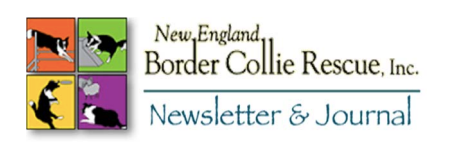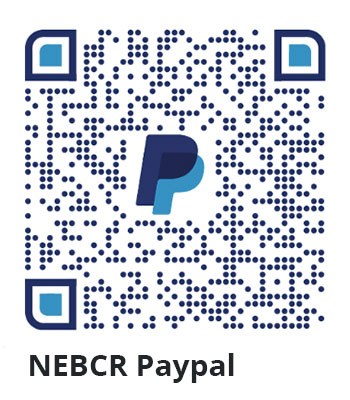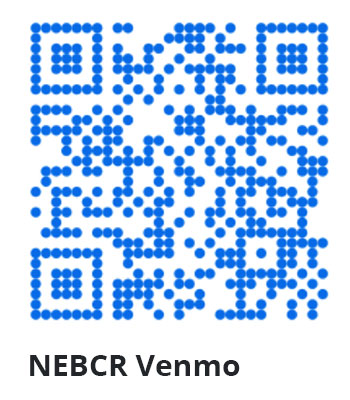Newsletter & Journal 2.0
VOLUME II NUMBER 1
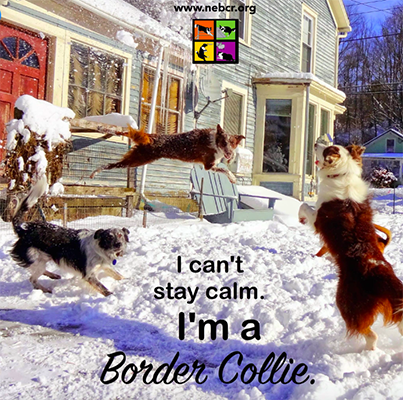
Co-Presidents: Bea Hamm & Sarah Hepburn
Treasurer: Mo Clark
Secretary: Emily Wu
Board of Directors: Monique Fisher, Elise Gouge, Marie Hinds
Website: Rebeca Kerr & Monique Fisher
Editors: Bea Hamm & Rebeca Kerr
Please send your content and pictures to us at: [email protected]
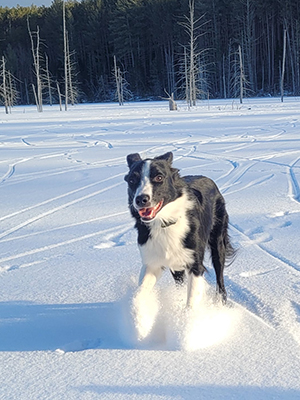
Featured:
Zep has been in rescue for a year and a half still waiting for his forever home. Zep is special needs but still has a lot to give back.
You’ll find his full bio here.
Meet Board Member of NEBCR Monique Fisher
I’ve been a border collie lover and owner for 23+ years, and joined NEBCR in 2001 as a volunteer shortly after we brought our first border collie Maggie home and our world was changed forever. My husband and I have since been blessed to share our home with 5 more border collies, all rescues, 4 of whom were NEBCR alumni. They include our current 16.5 year old Lyn who came to us as a foster dog with a broken leg 14.5 years ago and very quickly let us know she had no intention of leaving.
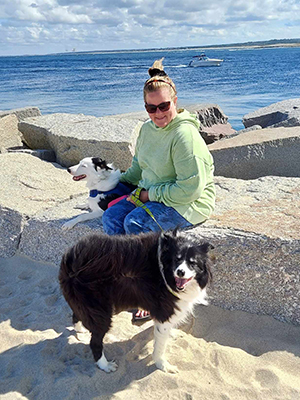
At various times over the past 22 years I’ve been active as an evaluator, transporter, events coordinator, foster home and much more. I’ve served on the intake and applications committees, as well as the board of directors (17+ years including currently) and previously served as president for 6 years.
In my day job, I’m a graphic designer and marketing director, and when I can, I try to lend these skills to NEBCR as well. I was delighted to design the NEBCR logo that has been in use for 20+ years, and each year I design the annual NEBCR calendar.
I currently share my home with 2 border collies – 16.5 year old Lyn (mentioned above) and 4.5 year old Remy – and my husband Brian, who is always more than willing to be volunteered for various NEBCR duties, most notably manning the grill at the annual NEBCR reunion.
It’s been my great pleasure and privilege to be a part of this organization for more than 2 decades, and to be some small part of the incredible work NEBCR volunteers do helping homeless border collies every day.

2024 Calendar
Though it becomes increasingly difficult to jump through all the hoops to get NEBCRs calendar published each year, I’m excited to say it’s now available. You will not be disappointed making this purchase as each sale helps fund the dogs we accept into rescue each year.
You not only help support us but have the pleasure of 12 full page photos of our rescues with their story displayed.
You’ll find the link here to make your purchase.
Giving Yourself Permission
by Lori Kline
Sunny lay quietly at Jenny’s feet while she relaxed, watching television, blissfully unaware of the turmoil in Jenny’s mind. It had been almost two years since Jenny first picked Sunny up from the breeder. She was drawn to the border collie and Sunny was not her first.
But this time it was different. At 10 weeks of age, Sunny was everything that Jenny had asked for from the breeder. The match seemed like it would be perfect.
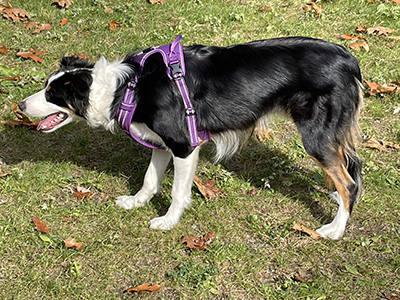
Charlie, a great example of second chances, now living his life to his full potential. Here seeing sheep for the first but not last time.
At 5 months of age, Jenny didn’t feel a connection with Sunny.
Sunny lay quietly at Jenny’s feet while she relaxed, watching television, blissfully unaware of the turmoil in Jenny’s mind. It had been almost two years since Jenny first picked Sunny up from the breeder. She was drawn to the border collie and Sunny was not her first.
But this time it was different. At 10 weeks of age, Sunny was everything that Jenny had asked for from the breeder. The match seemed like it would be perfect. At 5 months of age, Jenny didn’t feel a connection with Sunny.
Sunny had difficulty with some environments and needed extra time to settle in. He would bark and lunge when something was a bit too much for him. During training, both Sunny and Jenny seemed to go through the moves but neither one of them were having fun.
Jenny thought to herself this was simply growing pains. She would never dream of rehoming a dog. Once she took in a dog, it was for life. Another year went by, and Sunny was no longer a puppy. While he had improved with his behaviors, there was no real bond between the two of them.
Jenny wanted to have a dog she could take on trails and outdoor eating, a dog she could do some sports with. While Sunny possessed all that would be required of him to satisfy these requirements, that lack of a relationship continued to eat at Jenny. She found herself spending less time with him. He spent more time engaging in his own activities of self-reward and other behaviors were becoming problematic.
For the first time in her life, questions started forming in her mind such as was she the best home for Sunny? Was she being fair to him? Or to herself? Jenny didn’t have children, but Sunny just adored them. He also gravitated towards the male humans in Jenny’s life and not to her. Each interaction with him brought anxiety to both.
It was becoming clear that another 12+ years with this animal was going to be an obligation, not a happy relationship.
Does this sound familiar? Have you ever found yourself in Jenny’s position?
Many of us feel obligated to continue with a relationship that we have invested our time, energy, and love in. But is that the right thing to do?
Each of us needs to ask ourselves what is right for you. At the end of the day, do you truly love this dog? If the answer is no, then do yourself and your pup a favor and let him enjoy life he was meant to have with someone who will love him as he deserves.
Sometimes it is life that throws us a curve. Maybe a parent has taken ill and suddenly needs around the clock care. Maybe you lose your job unexpectedly and find it difficult to even pay the electric bill.
No one can say when the right time is to give up an animal. Nor should they judge anyone for making that decision. While there are a few individuals in this world who see animals as an accessory, I choose to believe that is a very small minority.
Some things to help you make your decision.
- Do you love this animal?
- Are you equipped to give this animal the kind of life he deserves/needs?
- Can you work through any behavior issues that you are seeing or is it something that may be a bit overwhelming for you?
- Can you handle any medical bills that may now lay in front of you that you didn’t anticipate?
- Are others in your life being negatively impacted by this animal in the house?
a. Can you adjust the living arrangements to alleviate this anxiety?
While some things can be overcome through management and encouraging others in your life to help, at the end of the day, what is best for the dog must be the very first consideration. What is best for you would come second to that.
Give yourself grace for making the difficult decision. It will be better for everyone involved once that decision is made.
ASK THE VET:
Building a Comprehensive Canine First Aid Kit
by Dr Sarah Hepburn
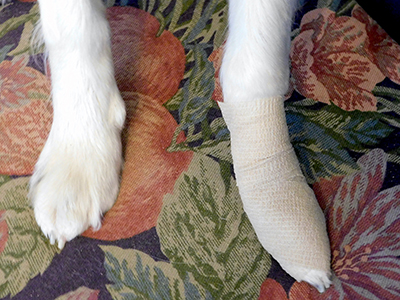
Unfortunately, despite our best efforts, dogs can encounter unexpected accidents and health issues that require immediate attention. In this article, I will discuss the essential items that should be in your canine first aid kit and why they are crucial.
Gauze Pads and Bandages: These are fundamental for covering wounds, controlling bleeding, and protecting injuries from infection. Dogs often experience minor scrapes and cuts during outdoor play or adventures.
Antiseptic Wipes or Solution: Proper wound cleaning is vital to prevent infection. Antiseptic wipes or solution can disinfect wounds before dressing them.
Scissors and Tweezers: Scissors are essential for cutting tape and gauze, while tweezers help remove splinters or foreign objects embedded in your dog’s skin.
Disposable Gloves: Protect yourself from potential infections when attending to your dog’s injuries by wearing disposable gloves.
Cotton Balls and Swabs: Useful for cleaning small wounds or applying ointments.
Digital Thermometer: Monitoring your dog’s body temperature is important when assessing their health. A digital thermometer can help identify fever, a sign of illness.
Tick and Flea Removal Tools: If you live in an area with ticks and fleas, specialized tools are vital for safe removal, preventing disease transmission.
Muzzle or Soft Cloth: Injured or distressed dogs may become aggressive. A muzzle or soft cloth can prevent biting while administering first aid.
Blanket or Towel: To keep your dog warm and comfortable during transport or while waiting for medical attention.
Tape: This secures bandages
Sterile Saline Solution: Useful for flushing out debris from your dog’s eyes or wounds.
Emergency Blanket: Helps keep your dog warm, preventing hypothermia in extreme cold or shock.
Disposable Syringes: Helpful for administering oral medications or flushing wounds.
Instant Cold Packs: Reduce swelling and inflammation in injuries like sprains or strains.
Nail Clippers or File: Trim or smooth broken nails.
Mild Pet Shampoo: Useful for cleaning your dog if they come into contact with toxins.
Emergency Glucose Gel: Useful in situations where your dog experiences a sudden drop in blood sugar, such as in diabetic dogs or during episodes of hypoglycemia.
Cone or E-Collar: Prevent licking or biting at wounds.
Emergency Food and Water: Pack dog food and a collapsible bowl.
Leash and Extra Collar: Control your dog during emergencies and prevent them from running away.
Antibiotic Ointment: This can be used to prevent infection in minor cuts and wounds. Apply it after cleaning the wound with antiseptic wipes or solution.
Vet Wrap: Vet wrap is a self-adhesive, flexible bandage that is excellent for securing dressings, splints, or wrapping sprains and strains.
Disposable Booties or Paw Protectors: These can protect your dog’s paws from injury or contamination when they need to walk on rough or hazardous surfaces.
Styptic Powder or Gel: Useful for stopping minor bleeding from small cuts or broken nails. It promotes clotting and helps prevent excessive bleeding.
Emergency Heat Pack: In case your dog becomes hypothermic or needs warmth in a cold environment, an emergency heat pack can help maintain their body temperature.
Pet First Aid Book: A comprehensive guide with step-by-step instructions in case of emergencies.
Emergency Contact Information: Include emergency phone numbers, such as your veterinarian’s contact details, an emergency animal clinic, and the poison control hotline. Time is crucial in emergencies, so have these numbers readily available.
Your Dog’s Medical Records: Keep copies of vaccination records, medical history, and prescribed medications in your first aid kit. This information is invaluable in emergencies.
By maintaining a well-stocked first aid kit tailored to your dog’s needs, you can provide immediate care during unexpected situations. However, remember that this kit doesn’t replace professional veterinary care. Always consult your veterinarian after providing initial emergency treatment. Remember to regularly check and update your supplies to ensure they’re in good condition and not expired. Preparedness can make a significant difference in safeguarding your canine companion’s health and well-being.
Trainer’s Corner:
Communication: Getting on the Same Page
by Elise Gouge, CPDT, CABC Certified Behavior
Consultant & Trainer
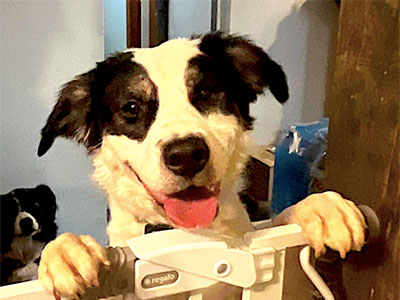
Imagine you just took in a foreign exchange student who is from another culture and speaks an entirely different language. They don’t eat the same way, communicate the same way, or necessarily find the same things enjoyable or fun. You can’t even tell how they are feeling most of the time!
For them, it’s a scary new world full of unknowns. They don’t want to offend the new family but they don’t know what’s right or wrong, only what they’ve done in the past. So many things are unrecognizable and just getting from morning the night is exhausting. It’s stressful and hard, despite the comfortable surroundings.
Where do the two of you start – new family and foreign family member? What’s the best way to learn about each other and reach a point where things feel fun, expressive and understood?
This is how it is with our foster dogs. No matter what our knowledge is about dogs, each foster dog is coming in with a totally different, unknown and mysterious background. We can’t make assumptions about what they know or don’t know, what they like or hate, and what they understand or find confusing.
As successful foster families, it’s our job to become professional communicators. We need to have efficient ways to get to know the dog so we can hopefully find them the best home as quickly as makes sense. What’s the best plan for doing this? In previous articles I’ve discussed the importance of going slow and I will reiterate that again. GO SLOW. But what else? Here’s a guide to how to put a training plan in place for your foster dog.
- Keep the first two weeks pretty sacred in terms of keeping everything separated and helping your new foster bond with you and keep to know routines. The more you keep things the same, the better.
- Keep your energy with your foster dog warm and kind, but not overbearing or intense. Herding breeds are especially sensitive to pressure and if you are TRYING to befriend them, get in their space or push them, they will likely go into fight or flight mode. Just be normal and go through the day with matter-of-fact energy like yep, it’s always been this way.
- Watch and listen. I cannot emphasize this enough. Your foster dog will tell you what helps them feel safe, how they like to eat food, when they like to potty and where, and everything else. Before trying to train and change things – listen to what they are already telling you. You don’t want to reinvent the wheel or make things hard so take what they tell you and build on it.
- Without being in their face about it, try to have fun with them. Act silly and see if they come closer or that pushes them away. YOU play with squeaky balls and ropes and puzzles and see if they are curious. Invite them but never force them.
- Log and video day to day life with your foster. It’s hard to see changes so often times having a log can really help.
- Identify priorities after you know your dog a bit. You can’t build Rome in a day, so work on one or two things at a time that are really important. I would consider crate training and house training very important. If you can tackle those first, the rest can wait. Use all of the dog’s food for crate and house training work and then move on to the next skill or behavior.
- After that, it’s time to start working on skills that will be beneficial for adoption and overall helpful. One excellent rule to implement is the Premack Principle. Premack basically states that you need to eat your veggies before getting dessert. For dogs, it’s that they need to do something you want (sit, down, wait, go settle) before they can have what they want (go outside, play ball, tug, have a treat, get a butt rub). It’s entirely contingent on what the dog wants and if they are unable to “eat their veggies” then no dessert. This is a lovely, concrete method of helping establish boundaries and rules in a neutral, non-punishing way. You can google Premack for all sorts of examples.
- If Premack is going smoothly then it’s probably time to take an obedience class or work on the classics like sit, down, wait, loose leash walking, come and leave it. This is good for their brain and helpful for everyday life. Don’t forget other skills like not jumping on guests, staying off counters and other lifestyle and house manners.
At any time, be prepared to back up or loop around to an earlier part of their plan. Settling in isn’t linear, there will be good days and hard days. But, if you are giving your dog space to show you their personality, helping them to understand the new rules and guiding them with compassion and patience, you should be able to reach all your goals and soon be talking the same language pretty fluently!
